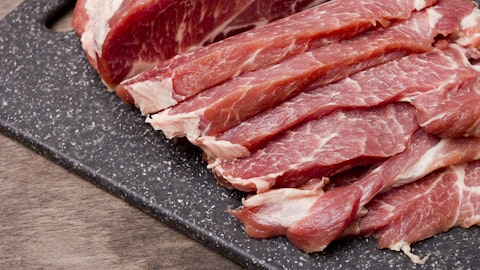Matthew Galvanoni: Yes. And Ben, just a couple of things to follow-up. One is I could say also foreign currency volatility is something we’re currently always monitoring there in Mexico. And your question relative to the storm, my understanding the storm hit the – off [coco] area, which does not, it’s not an area that has a lot of production for us, and it has now thankfully dissipated. The storm is not nearly severe. So, we’re not seeing, at this point, any severe impacts to our operations at this time.
Ben Bienvenu: Okay. Great. Thanks so much.
Operator: The next question comes from Andrew Strelzik of BMO Capital. Please go ahead.
Andrew Strelzik: Hi. Good morning. Thanks for taking the questions. My first one is on some of the operational improvements. In the press release you alluded to on covering some incremental opportunities. Can you elaborate a little bit on what those are? And is there any way to quantify, I guess, the magnitude of those or the contributions of those improvements that you’ve realized so far this year and then the new ones going forward?
Fabio Sandri: Sure. Thank you for the question, Andrew. Yes, every year in the budget time, we identify the opportunities for operational improvements. We call that opening the gaps. And then also during the budgeting we created action plans to close those gaps and capture those operational improvement. Typically, we expect around $100 million to $200 million in improvements every year, doing things to more efficiently capturing better yield, better live operations and better mix. So last year was no different. We identified a lot of operational improvements that we can take I think the biggest challenge was the staffing of our plants. So, we were not fully staffed. It was very difficult to attract talent to our operations. And as the 2023 started, we’re seeing an improvement in that scenario.
And as I mentioned, right now, we are fully staffed. So, I think the challenge right now is to train all of our team members to operate efficiently and capture those improvements, as I mentioned.
Andrew Strelzik: Okay. Great. That’s helpful. And then I guess I just had a question more broadly on your market share. I mean given some of the dynamics and the sales trends and distribution, et cetera, that you’ve called out. It would seem certainly like you’re gaining share in the U.S. And I’m, in particular, interested on the distribution side with respect to case ready. If you could talk maybe about what’s going on there? I mean do you think that you’re taking share from other key players in the industry? Or is there a broader growth here? That you’re servicing with the key customers that fits into? How would you characterize what’s going on there? Thanks.
Fabio Sandri: Yes. That’s a great question. When we think about market share, we don’t look overall. We look into the individual segments, right? And as we mentioned, we have a very well-balanced portfolio. We are the leaders in the Small Bird category, and we’ve been gaining market share as our presence with key customers have been increasing. So we’re gaining market share with our key customers and our key customers are winning in the marketplace, and that’s more different on the case-ready segment. We’ve been growing our market share because we’ve been increasing our market share with our key customers and our key customers are growing faster than all the other customers or players in that segment. As an example, we increased, the market increase in Q3, 3.4% in the fresh category in the retail, and we increased 9%.
Because of our penetration in those key customers, again, that are growing faster than all others. On the Big Bird category, I think there have been a lot of additions in the last for 5 years in this industry, and we have not increased in number of plants. Of course, we have improved in terms of number of heads and we have improved in terms of yields. But in that category, I think we’ve been having a very stable market share.
Andrew Strelzik: Great. Very helpful perspective. Thank you very much.
Operator: The next question comes from Peter Galbo of Bank of America. Please go ahead.
Peter Galbo: Hi. Good morning.
Fabio Sandri: Good morning, Peter.
Peter Galbo: Maybe to actually follow-up or ask Andrew’s question a bit different on market share. One of the dynamics I feel like we’re seeing, at least within U.S. retail, is maybe a shift from kind of the center store or some of the frozen categories to the perimeter, just as consumers are kind of being more, choosy with dollars. Given you guys kind of have exposure in both parts that just, it seems like that kind of is what you’re seeing as well, maybe that the perimeter is gaining share relative to the frozen or seller store categories. But wondering if you can just comment on kind of that dynamic and what you’re seeing?
Fabio Sandri: No, I think it’s a great question, Peter. And yes, I think we are seeing customers shifting from the frozen category to the fresh category, maybe on IQS to the fresh category. I think we have a great offering that differentiates our key customers. As we mentioned, we produce tailored products to our customers that are differentiated and targeted towards their specific segments. So we have Fresh from Florida. We have Fresh from Texas. We have differentiated offerings in terms of no antibiotic ever in terms of Veggie Fed that we tailor our products to their specific customers. We augment that with our, just BARE brand, which is a higher antibiotic offering that complements the portfolio of our key customers. And that’s why I mentioned we’ve been growing on the fresh category.
Now on the frozen category, the fully cooked category for Pilgrim’s’ have been increasing year-over-year, which are Just BARE launches and Just BARE penetration. So for us, what we are seeing is the growth in the frozen fully cooked category through our Just BARE and Pilgrim’s brands and a growth in our fresh offerings with partnership with key customers on customer brands. What is reducing and you’re absolutely right. This is what we call IQS, which is more a commodity operation that is a frozen offering of a non-value-added breast meat or wind or tender.
Peter Galbo: Got it. No, that’s helpful. And Matt, your comments just around the balance sheet, right, the leverage position has kind of improved here or should continue to improve here into the next quarter. Just given where the cash position sits on the balance sheet, how are you thinking about opportunities to redeploy the cash, whether that be opportunistic share buyback, which you guys have done in the past or potentially M&A opportunities that are out there?
Matthew Galvanoni: Yes. And I think just one thing just to make sure everyone’s cognizant of. We see the cash balance at the end of the quarter. That number will be down $350-ish million with the tender offer we did, because we did the bond offering for $500 million and paid down debt for $850 million. So just to make sure people are cognizant there that our cash balances are close to that $500 million, $550 million area at this stage. Our view on this, look, is we want to grow, but we’re going to grow in a disciplined manner. We’ve done some nice CapEx with some key customers for some different attributes that they may want in their products that where we’ve had some higher CapEx run rate, more of an organic growth perspective. And we see more of those opportunities coming. And so, the way we look at it from a cash perspective right now is growth in a disciplined manner. I don’t know, Fabio, do you want to add anything further?


